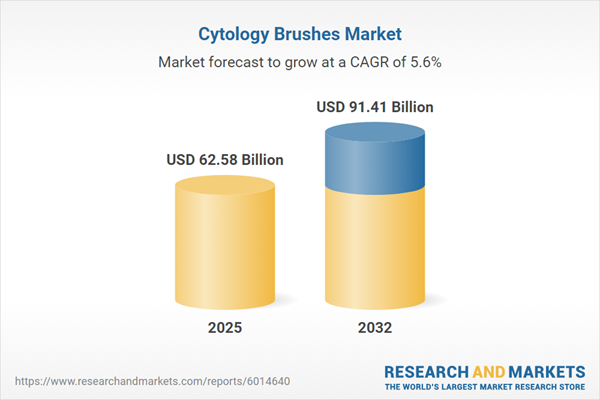Speak directly to the analyst to clarify any post sales queries you may have.
Cytology brushes have become essential tools for healthcare organizations seeking to enhance diagnostic processes, streamline laboratory operations, and maintain quality and compliance. Senior decision-makers in both clinical and research settings recognize these specialized devices as critical for modernizing specimen collection and supporting process standardization.
Cytology Brushes Market Snapshot: Size & Growth Dynamics
The cytology brushes market continues to expand globally, driven by priorities such as improved diagnostic precision, increased automation within laboratory settings, and the adoption of digital solutions in daily workflows. In 2024, the global market is valued at USD 59.24 billion, projected to reach USD 62.58 billion by 2025 and USD 91.41 billion by 2032, representing a compound annual growth rate of 5.57%. Several factors contribute to this sustained growth, including effective global supply chain strategies, ongoing advancements in brush design and materials, and organizational agility in addressing evolving regulatory demands. Hospitals, laboratories, and research facilities benefit from these enhancements by achieving more reliable procurement and optimized operational performance.
Cytology Brushes Market Scope & Segmentation
A comprehensive evaluation of the cytology brushes market highlights distinct opportunities for strategic development and operational improvement. Senior leaders can leverage segmentation to align organizational focus and respond to sector-specific challenges efficiently.
- Application Areas: Bronchial, endobronchial, transbronchial, cervical cancer screening, liquid-based cytology, ear/nose/throat, gastroenterology, and urology procedures support broad diagnostic workflows and clinical models.
- Product Types: Bronchial, endoscopic, cervical, and spiral cytology brushes are engineered for specific anatomical targets and compatibility with laboratory platforms.
- Reusability Options: Disposable and reusable brush versions address infection prevention, cost management, and healthcare sustainability objectives.
- Distribution Channels: Direct sales channels, distributor networks, and digital procurement platforms provide flexibility and adaptability in acquisition strategies.
- End Users: Ambulatory surgical centers, diagnostic laboratories, clinics, and large hospital systems leverage cytology brushes to drive workflow efficiency and enable consistent sample quality.
- Material Types: Foam, nylon, and plastic are selected to maintain specimen integrity, ensure patient safety, and standardize clinical procedures.
- Regional Scope: The market spans the Americas, EMEA, and Asia-Pacific regions, with regulatory frameworks and demand patterns influenced by countries such as the United States, Canada, China, Japan, Brazil, Germany, and India.
- Key Players: Becton, Dickinson and Company; Hologic, Inc.; CooperSurgical, Inc.; Cardinal Health, Inc.; and Thermo Fisher Scientific Inc. play instrumental roles in shaping product standards and market development through collaborative innovation.
Key Takeaways: Strategic Insights for Stakeholders
- Ergonomic enhancements in cytology brush design improve clinician comfort and support sustained high-throughput operations in laboratory environments.
- Seamless integration with digital pathology solutions and liquid-based diagnostic workflows positions healthcare organizations for ongoing digital transformation efforts.
- Expansion of laboratory automation, coupled with standardized diagnostic protocols, contributes to reliable and reproducible results across a variety of care settings.
- Collaborative initiatives with research teams and advancements in molecular diagnostic compatibility drive the development of brush solutions that meet emerging clinical requirements.
- Broader product portfolios targeting respiratory, gastrointestinal, and cervical applications support continuous alignment with regulatory expectations and evolving clinical best practices.
- Access to an array of distribution channels and materials strengthens procurement agility and helps standardize operational performance on a global scale.
Tariff Impact: United States Trade and Supply Chain Adjustments
US cytology brush manufacturers are proactively adapting to tariffs on synthetic materials by optimizing supply sources and increasing the automation of production lines. These efforts reinforce domestic supply chain resilience and align operations with updated trade regulatory requirements.
Methodology & Data Sources
This report's findings are grounded in an integrated research approach, combining thorough secondary analysis, extensive regulatory review, and structured discussions with laboratory and supply chain professionals. By validating through multiple sources, the report delivers actionable, executive-ready insights tailored to the cytology brushes market.
Why This Report Matters
- Provides actionable guidance on procurement processes and life cycle management, supporting compliance in global healthcare markets.
- Explains the primary drivers of technology adoption and workflow optimization, setting the foundation for effective strategic planning.
- Equips senior leaders with the insight needed to adapt to regulatory change and select products aligned with prevailing standards of care and operational goals.
Conclusion
Cytology brushes remain integral to optimizing diagnostic workflows and enhancing procurement strategies, empowering healthcare organizations to sustain laboratory improvements and respond effectively to market shifts.
Additional Product Information:
- Purchase of this report includes 1 year online access with quarterly updates.
- This report can be updated on request. Please contact our Customer Experience team using the Ask a Question widget on our website.
Table of Contents
3. Executive Summary
4. Market Overview
7. Cumulative Impact of Artificial Intelligence 2025
Companies Mentioned
The companies profiled in this Cytology Brushes market report include:- Becton, Dickinson and Company
- Hologic, Inc.
- CooperSurgical, Inc.
- Cardinal Health, Inc.
- Thermo Fisher Scientific Inc.
Table Information
| Report Attribute | Details |
|---|---|
| No. of Pages | 190 |
| Published | November 2025 |
| Forecast Period | 2025 - 2032 |
| Estimated Market Value ( USD | $ 62.58 Billion |
| Forecasted Market Value ( USD | $ 91.41 Billion |
| Compound Annual Growth Rate | 5.5% |
| Regions Covered | Global |
| No. of Companies Mentioned | 6 |









